Discover the Best Board Games for Every Player
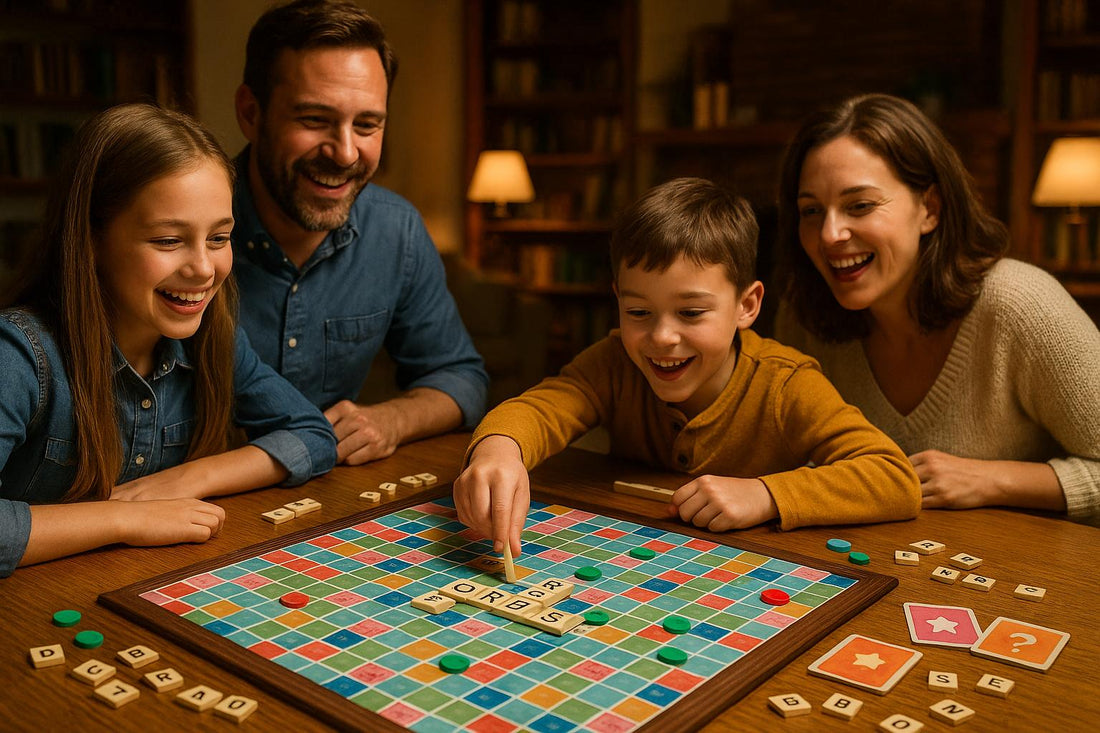
Top 5 Word Board Games for Family Fun
Word board games are a great way to bring families together, offering a mix of fun, learning, and quality time. They help improve vocabulary, communication, and problem-solving skills while providing screen-free entertainment. Below are the top 5 word board games for family game night:
- Codenames: Duet: A cooperative game for ages 11+, focusing on deduction and teamwork. Best for 2 players, with quick 15-minute rounds.
- Just One: A creative guessing game for ages 8+, supporting 3–7 players. Each round lasts about 20 minutes.
- Bananagrams: A fast-paced, tile-based game for ages 7+, perfect for 1–8 players. Playtime is around 10–20 minutes.
- Letter Slide: A spelling and speed game for ages 7+, accommodating 2–8 players. Sessions last about 20 minutes.
- Clover Leap: A grammar and movement game for ages 5+, designed for 2–6 players. Playtime is 30 minutes.
Quick Comparison
| Game Name | Age Range | Player Count | Skills Developed | Average Playtime |
|---|---|---|---|---|
| Codenames: Duet | 11+ | 2-8 | Deduction, teamwork | 15 minutes |
| Just One | 8+ | 3-7 | Vocabulary, creativity | 20 minutes |
| Bananagrams | 7+ | 1-8 | Spelling, anagram skills | 10–20 minutes |
| Letter Slide | 7+ | 2-8 | Quick thinking, spelling | 20 minutes |
| Clover Leap | 5+ | 2-6 | Grammar, movement | 30 minutes |
These games cater to various ages, group sizes, and skill levels, making them perfect for family bonding. Start your next game night with one of these options for both fun and learning!
Top Word Games
How to Pick the Right Word Board Game
Choosing the perfect word board game for your family can feel like a challenge, but the key lies in aligning the game with your family's ages, interests, and group size. When you find the right fit, everyone stays engaged, and game night becomes a highlight. Here’s how to make the best choice for your family.
Age Range and Number of Players
The first step is to match the game to the ages and abilities of your players. A game that’s fun for teens might leave younger kids feeling excluded, while games designed for little ones may not hold the attention of older players. Focus on the youngest player’s skills when deciding. For kids aged 3–8, simple games with easy-to-follow rules can help them bond with others and build resilience under pressure.
Flexibility in player count is another factor to consider. Whether it’s just two players or a larger group with friends or grandparents, pick a game that works well for different group sizes. Also, think about the challenge level - something too easy can feel dull, while overly complicated rules might frustrate younger participants.
Finding the Right Difficulty Level
The complexity of the game should match your family’s experience with board games. Games that are too basic can lose their appeal quickly, while overly intricate ones might overwhelm younger or less experienced players.
For families with children who struggle with losing, cooperative games can be a great option. These games encourage teamwork toward a shared goal, making the experience less stressful and offering adults the chance to model good sportsmanship. Card games are another excellent choice for beginners, as they often have straightforward rules and allow for flexibility - such as playing with open hands or giving extra time to slower players.
You can also use scaffolding techniques to bridge skill gaps between players. For instance, starting the game with everyone’s cards visible or having older players explain their strategies can help younger participants learn and feel included.
Learning and Social Benefits
Word games do more than entertain - they’re great for cognitive growth. They help improve reasoning, problem-solving, and focus. Beyond mental benefits, the social aspects of playing together are just as important. A 2019 Baylor University study discovered that couples who played board games released oxytocin, the hormone associated with bonding. This effect extends to families, creating stronger connections through shared activities. As sociologist Samuel Tobin from Fitchburg State University puts it:
"The sharing is more important than the message. It's the fact that we're doing something together that matters."
Word games also support academic growth by building vocabulary, improving spelling, and encouraging critical thinking. They teach life skills like setting goals, practicing patience, and handling both wins and losses gracefully. To make the most of these benefits, pick games that align with specific skills you want your children to develop. For instance, if your child needs help with spelling, choose games that focus on letter patterns. If expanding vocabulary is a priority, go for games that naturally introduce new words in context. For children with language challenges, look for games that allow modifications, such as longer turns, note-taking, or simplified vocabulary, so everyone can participate confidently and enjoy the experience.
Top 5 Word Board Games for Family Fun
Looking for ways to combine fun, learning, and quality time? These five word board games bring together exciting gameplay, social interaction, and educational benefits, making them perfect for family game nights.
Codenames: Duet

Codenames: Duet puts a cooperative twist on the classic spy-themed word game. Players team up as secret agents, giving one-word clues to help their partner identify the correct code words from a grid of 25 cards. The game’s collaborative nature encourages teamwork and communication. Each round lasts about 15–30 minutes, making it ideal for quick sessions of bonding. Designed for ages 11 and up, this game works best with two players.
Just One
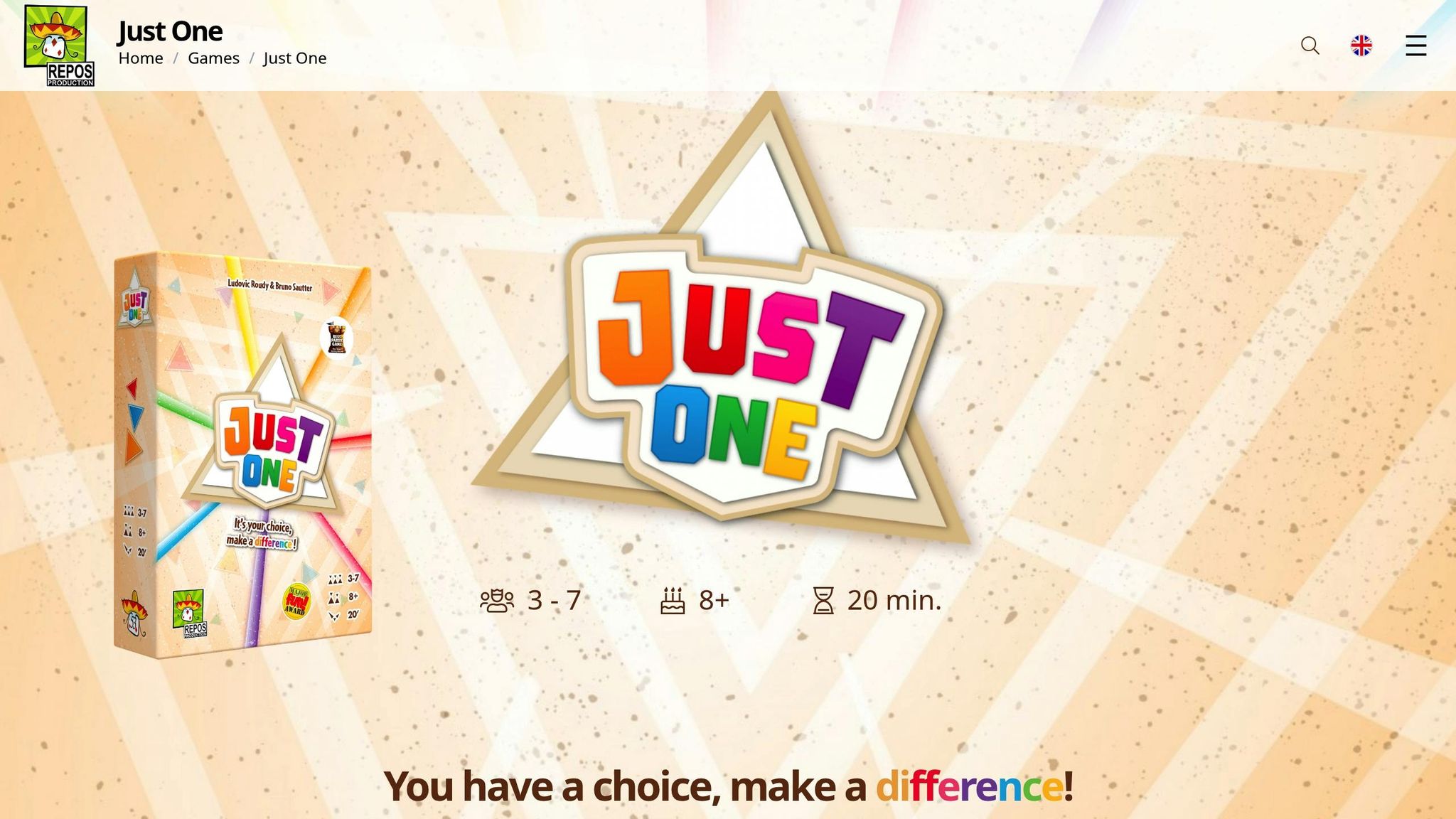
Just One is a guessing game that sparks laughter and creativity. One player tries to figure out a mystery word while the other players write down one-word clues to help. But here’s the twist - any identical clues are removed before the guesser sees them, adding a layer of strategy and originality. This fast-paced game enhances vocabulary and critical thinking, with rounds lasting around 20 minutes. It’s suitable for ages 8 and up and accommodates 3–8 players.
Bananagrams
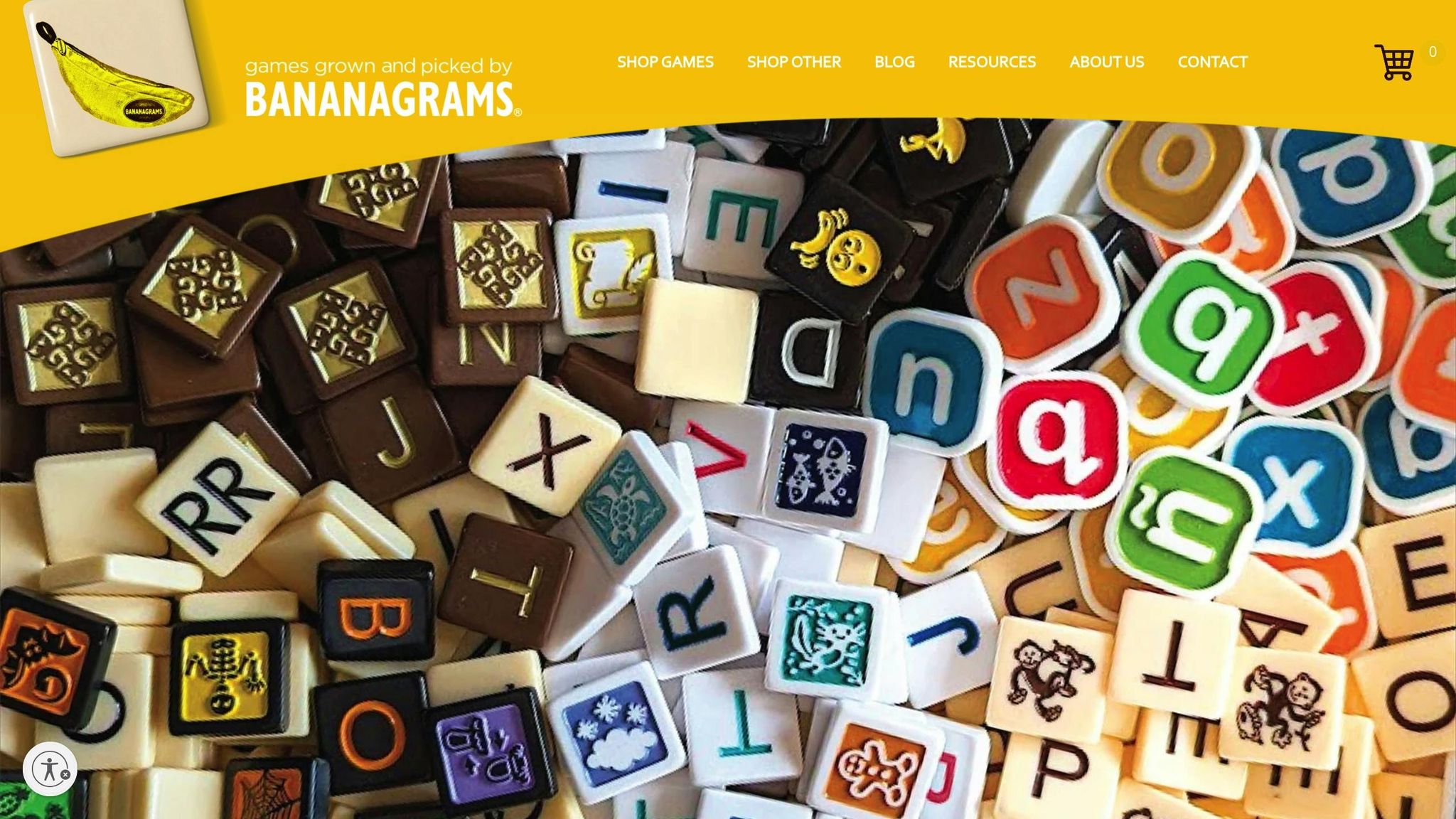
Bananagrams is a tile-based word game that’s perfect for families on the go. Players race to use all their letter tiles to create their own crossword grids. This game strengthens spelling, introduces anagrams, and improves familiarity with word structures. Its compact banana-shaped pouch makes it easy to bring along for travel, camping, or even a quick game while waiting. Each session typically takes 10–20 minutes. Suitable for ages 7 and up, it supports 1–8 players, making it versatile for both solo and group play.
Letter Slide
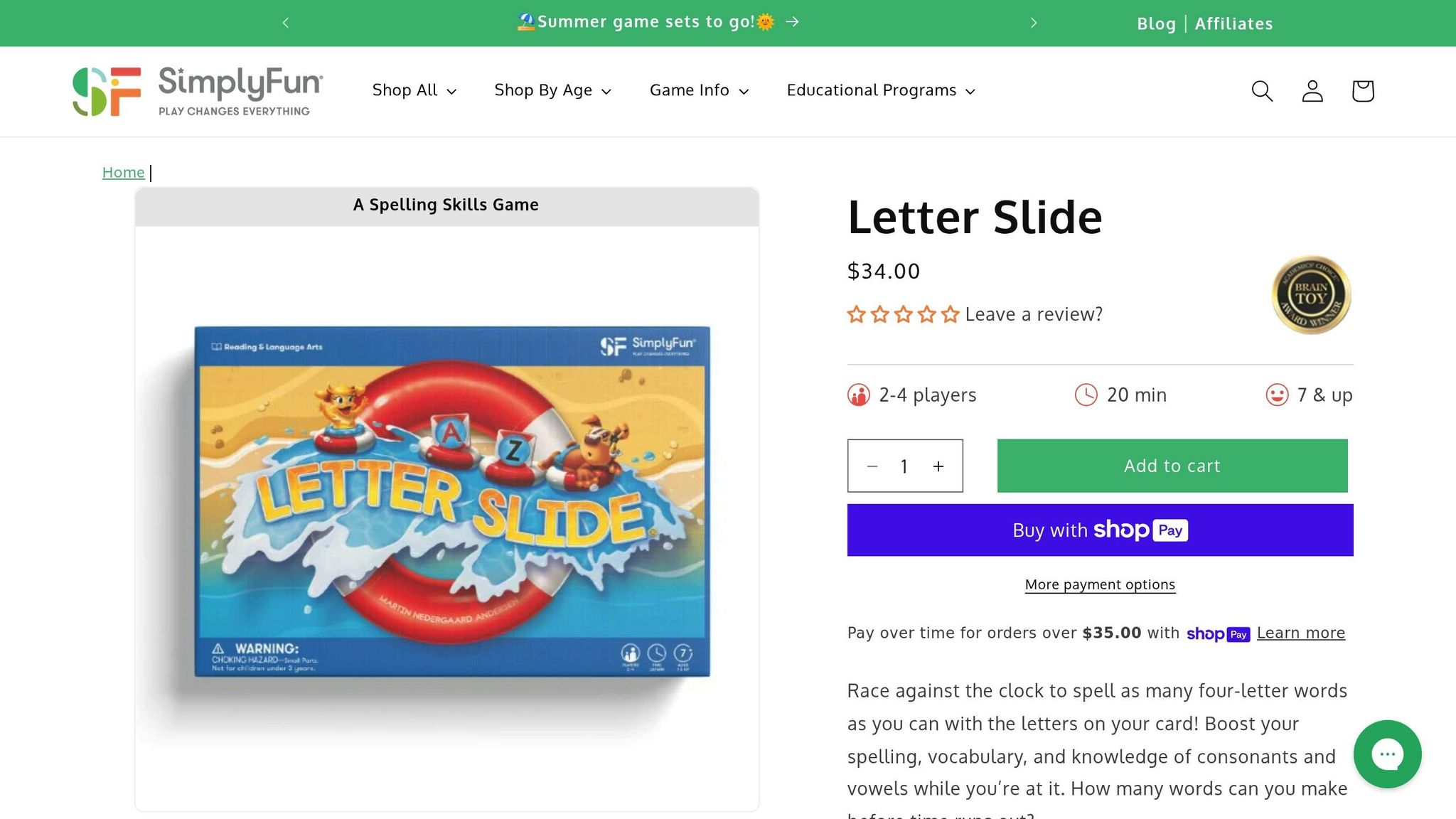
Letter Slide combines speed and spelling in a high-energy challenge. Players slide color-coded tiles to form four-letter words under timed conditions. This setup not only expands vocabulary but also sharpens word recognition and pronunciation skills. It’s especially great for early spellers since all words are limited to four letters, keeping the challenge approachable yet rewarding. Parents and educators can use this game to encourage creativity and reinforce proper pronunciation. Designed for ages 7 and up, it’s a fun way to make learning feel like play.
Clover Leap
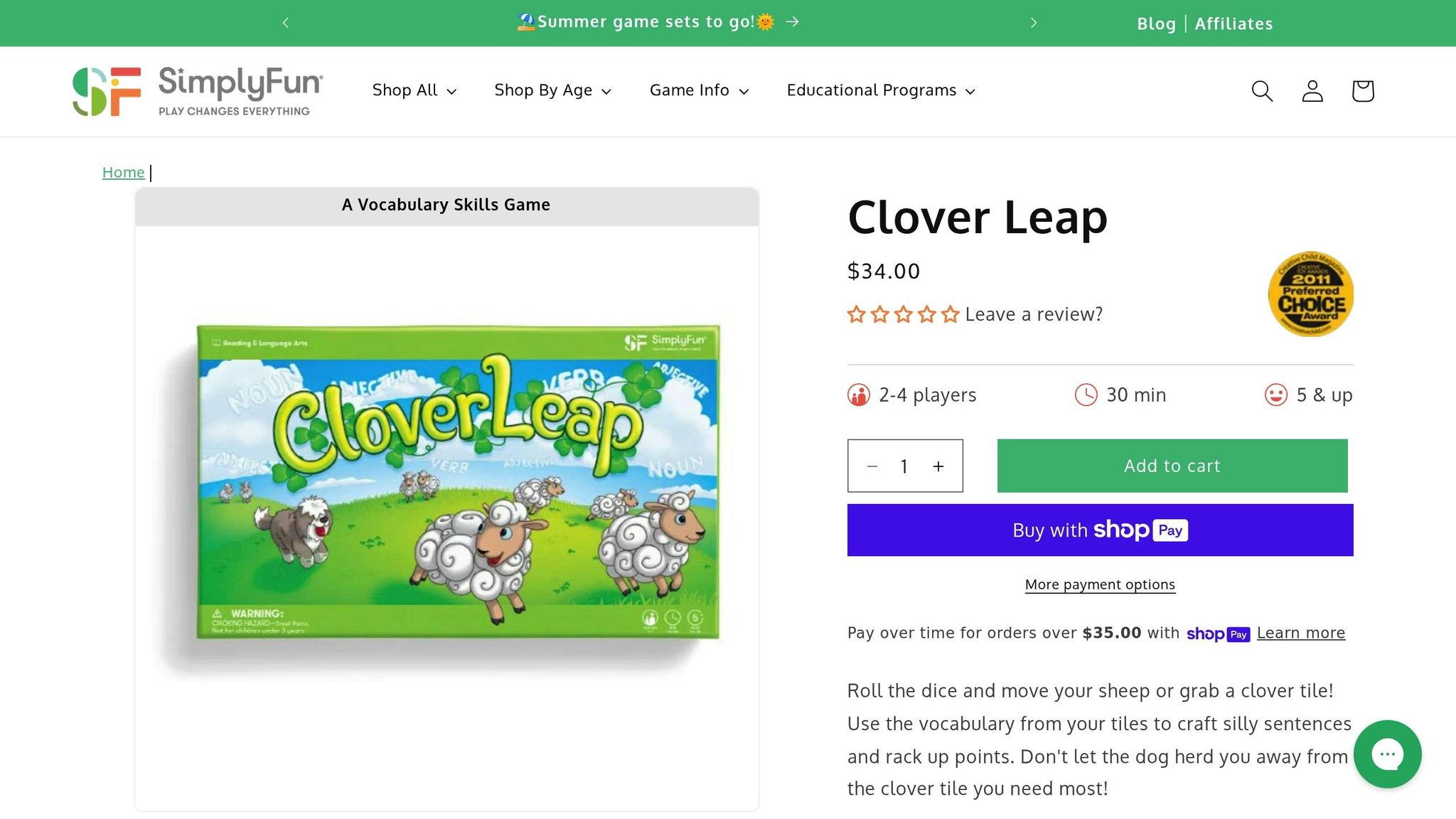
Clover Leap adds a physical twist to word games. Players hop between foam lily pads while building sentences and learning basic grammar. This interactive approach is perfect for kids who thrive with hands-on activities, combining language development with gross motor skills. The durable foam pieces are designed for active play, making it a great choice for energetic learners. Quick to set up and easy to play, it’s ideal for ages 5 and up.
Whether you’re after teamwork, creativity, portability, speed, or active learning, these games offer something for everyone. Dive into one of these options for a family game night that’s both fun and enriching!
Game Comparison: Finding the Best Match
Picking the perfect word game for your family comes down to understanding your group’s preferences, ages, and the kind of vibe you want for game night. Whether you're after collaboration, competition, or a more active experience, each game offers something distinct. Here's a breakdown to help you choose the right fit for your family.
Codenames: Duet is a fantastic option if you're looking for a game that challenges your brain. It’s all about coming up with clever, one-word clues to guide your partner while navigating a web of hidden connections. The cooperative nature and unpredictable outcomes add a layer of excitement.
Just One brings a lively, party-style atmosphere to the table. The twist? Players can’t use duplicate clues, which often leads to hilarious and unexpected moments. It’s perfect for gatherings where shared laughter is the goal.
Bananagrams is all about speed and competition. Players race to create their own crossword grids, sharpening their spelling and anagram skills along the way. It’s fast-paced and keeps everyone on their toes.
Letter Slide mixes wordplay with puzzle-solving. Using a sliding block mechanism, it offers over 500 challenges across seven difficulty levels, making it a game that stays fresh and engaging over time.
Clover Leap takes a different approach by combining learning with movement. It’s designed to keep young, energetic players active while they build grammar skills and have fun.
Game Comparison Table
Here’s a quick look at the key details to help you decide:
| Game Name | Age Range | Player Count | Skills Developed | Average Playtime |
|---|---|---|---|---|
| Codenames: Duet | 11+ | 2-8 | Deduction, teamwork | 15 minutes |
| Just One | 8+ | 3-7 | Vocabulary, creativity | 20 minutes |
| Bananagrams | 7+ | 2-6 | Spelling, anagram skills | 15 minutes |
| Letter Slide | 7+ | 2-8 | Quick thinking, spelling | 20 minutes |
| Clover Leap | 5+ | 2-6 | Grammar, movement | 30 minutes |
If you're looking for flexibility in group size, Letter Slide is a great choice, accommodating anywhere from 2 to 8 players. For larger groups, Just One shines as a crowd-pleaser. Meanwhile, Codenames: Duet offers a cooperative challenge that works equally well for small or medium-sized groups.
For younger, active players, Clover Leap combines movement with learning in a way that keeps kids engaged. Bananagrams and Letter Slide are excellent for building foundational spelling and quick-thinking skills. Older players may enjoy the strategic depth and teamwork of Codenames: Duet.
Playtime also varies: Codenames: Duet and Bananagrams are quick, clocking in at about 15 minutes, while Clover Leap offers a more extended 30-minute session.
sbb-itb-1ed942f
Tips for Better Family Game Nights
Creating memorable game nights is all about setting the right atmosphere and paying attention to the little details that make the evening special.
Switch Between Different Games
Keeping things fresh is key to an engaging game night. Rotating between different games ensures everyone stays interested and excited. Plus, letting each family member take turns picking the game gives everyone a sense of involvement. One week could feature the fast-paced fun of Bananagrams, while the next might focus on the cooperative problem-solving of Codenames: Duet.
To avoid arguments over game choices, consider using a fixed rotation schedule. This way, everyone knows when it’s their turn, and it builds anticipation for their pick. You can also spice things up by introducing themed nights. For example:
- Speed-based games like Bananagrams for a high-energy evening.
- Cooperative games like Just One for teamwork-focused fun.
- Puzzle-solving games like Letter Slide for a mental challenge.
This variety not only keeps things interesting but also allows you to tweak the rules or game styles to suit players of all ages.
Adjust Rules for Younger Players
Making small adjustments to the rules can help younger players feel included without taking away the challenge. For instance, you can allow hints when they get stuck. In Just One, older siblings could offer an extra clue, or parents might quietly suggest options during a tricky Letter Slide round. These little changes keep the frustration at bay and the fun going.
Younger kids also love having roles that make them feel important. Assign them as the "official dice roller" or the timekeeper during timed games. These small responsibilities help them feel involved, even when it’s not their turn.
Visual aids can also be a game-changer for explaining rules and making them easier to follow.
"We've succeeded in playing fun, engaging rounds with younger children by modifying the rules to shorten the game."
– Lynna, Blogger at Your Large Family Homeschool
By tailoring the experience, you can ensure everyone, regardless of age, stays engaged and has a great time.
Set Up a Fun Environment
The right setting can elevate the entire experience. Start by creating a distraction-free space. Turn off electronics, and set up a well-lit, circular seating area that encourages interaction. Add a snack station nearby to avoid interruptions mid-game, and play some soft background music to keep the mood upbeat.
Short breaks for snacking or stretching can also help, especially during longer game nights. Using a timer for breaks ensures the evening stays structured and keeps energy levels steady.
Flexibility is just as important. If a game isn’t working for the group, don’t hesitate to switch it up or tweak the rules on the spot to keep the fun alive.
"Family game nights are meant to be fun, relaxing, and enjoyable for everyone. You might feel more at ease if you don't get caught up in having the evening go absolutely perfectly."
– BlissLights LLC
Finally, celebrate everyone’s efforts with lighthearted awards like "Best Team Player" or "Most Creative Strategy." These small gestures make the evening rewarding for everyone, regardless of who wins.
Conclusion
Word board games bring families something truly valuable in today’s tech-driven world. Beyond the fun, these games offer proven benefits for both the mind and relationships, turning family time into a meaningful, screen-free experience. With over 70% of families finding it hard to balance screen time and face-to-face interaction, word games offer a fantastic way to reconnect and enjoy quality time together.
Studies reveal that 91% of parents with children aged 3–9 consider board games a favorite family activity, with a rising interest among kids aged 6–9, increasing by 10% year over year. These games not only boost language skills and spark creativity but also strengthen family bonds. Laughter and shared moments release endorphins - those natural "feel-good" chemicals - while teaching patience, improving communication, and easing stress.
The evidence is clear: families who make time to play together build stronger connections and develop better communication habits.
"Research has found that making time to play games together supports more effective, open family communication and a greater sense of togetherness." - Kelseanna Hollis-Hansen, PhD, MPH, UT Southwestern Medical Center School of Public Health
Want to start your own family game night? Check out Brain-Games.lv/en/ for a variety of word board games that promise years of fun, bonding, and skill-building for the whole family.
FAQs
What’s the best way to pick a word board game that works for all ages in the family?
Choosing the Right Word Board Game for All Ages
Finding a word board game that works for a family with different age groups doesn’t have to be tricky. The key is to focus on games that offer flexible rules or adjustable difficulty levels, making it easy for everyone to participate. For example, Scrabble Junior features a double-sided board - one side for younger kids just starting out and another for more seasoned players. Other great picks include Bananagrams and Zingo Word Builder, both of which pair fast-paced gameplay with simple rules, keeping both kids and adults entertained.
It’s also worth considering games that promote teamwork or social interaction. These types of games can help bridge the age gap and create shared moments of laughter and connection. Ultimately, the best game is one that strikes the perfect balance between being fun and challenging for everyone at the table.
What are the benefits of playing word board games with kids?
Playing word board games with kids is an enjoyable way to enhance their learning and social abilities. These games naturally build vocabulary, improve spelling, and strengthen reading comprehension, all while sparking critical thinking and creativity. The best part? They make learning feel like play, keeping kids interested and eager to participate.
Beyond the academic perks, word games also nurture essential social skills like cooperation, patience, and taking turns. Plus, they offer a chance for families to connect and share meaningful moments, making them a fantastic option for quality time together.
How can I make word board games more accessible for younger or less experienced players?
Making word board games easier to enjoy can be as simple as tweaking a few elements. Start by simplifying the rules or creating an easier version of the game. This can help younger players or those new to board games feel more at ease. Using larger, easy-to-hold pieces and adding visual aids - like bright colors or clear symbols - can also make the experience more engaging and straightforward for everyone.
Another idea is to introduce flexible scoring or adjustable difficulty levels. This allows players with different skill levels to join in and have fun without feeling left out. These small changes not only make the game more inclusive but also encourage teamwork and ensure the whole family can enjoy playing together.






